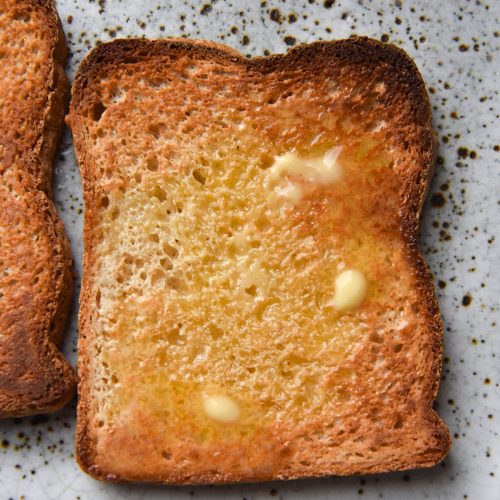
Grain free bread without xanthan gum
Gluten free, nut free, xanthan gum free
Equipment
- 10 x 10 x 23 cm steel bread tin (I use USA pan Pullman tin in size small)
Ingredients
- 400 g cassava flour
- 100 g tapioca flour
- 100 g potato starch
- 30 g milk powder
- 20 g psyllium husk powder
- 20 g white sugar
- 7.5 g (1 Australian sachet) yeast
- 12-13 g salt
- 550-600 g water
- 50 g melted butter
- 2 extra large eggs (45-55g, weighed out of shell)
- 1 tablespoon (20ml) milk of choice to brush the loaf (optional)
Instructions
- Whisk the dry ingredients together in a large glass or plastic bowl.
- Add the wet ingredients and whisk until there are no lumps remaining. The batter will look very thin once whisked, but it will firm up considerably after 5 minutes.
- Cover the bowl and allow to proof for one hour.
- Very lightly grease and line 10 x 10 x 23 cm steel Pullman loaf pan. After one hour, gently punch down the dough and use moistened hands to transfer the dough into the lined Pullman pan. Use a wet hand to press down the dough and smooth out the top. Proof the dough for another hour or until it has reached the top of the loaf pan.
- While the loaf is proofing, thoroughly preheat the oven to 200C/400F. 10 minutes before baking, add a cake pan or oven safe container filled with boiling water to the bottom of the oven. A steamy environment will help with oven spring and keeping the loaf from getting too dry.
- If you like, brush the loaf lightly and gently with milk before placing it in the oven.
- Bake for 30 minutes. The top should be golden and lightly domed. Lightly tent the loaf with a piece of foil, then bake for an additional 50 minutes. The foil should just cover the top of the loaf while allowing air to circulate. It should not be tightly adhered to the loaf.
- Once baked, carefully remove from the Pullman pan and take the baking paper off the loaf. Allow to cool on a wire rack at least until the loaf is completely cool – ideally overnight.
Notes
- The body of this post is filled with all my tips and tricks for this grain free bread. I recommend you read them for best results.
- I have no substitutions for any of these ingredients at the moment. You can experiment with how much water your loaf needs. Every brand of flour will vary.
- Proofing bread in a cold kitchen or winter climate will take longer than a hot summer climate.
- If you don’t need to use the oven, you can leave the loaf in a turned off oven to cool. This can help set the sides and ensure the loaf is cooled. I recommend removing the dish of hot water and keeping the foil tent on the loaf.
Tried this recipe?Let us know how it was!